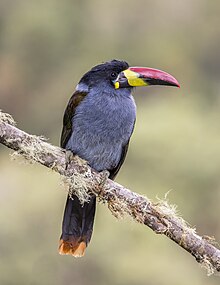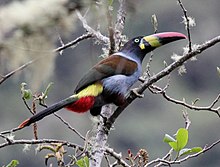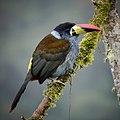| Grey-breasted mountain toucan | |
|---|---|

| |
| A. h. hypoglauca, Colombia | |

| |
| A. h. lateralis, Peru | |
| Conservation status | |
 Near Threatened (IUCN 3.1) | |
| Scientific classification | |
| Domain: | Eukaryota |
| Kingdom: | Animalia |
| Phylum: | Chordata |
| Class: | Aves |
| Order: | Piciformes |
| Family: | Ramphastidae |
| Genus: | Andigena |
| Species: | A. hypoglauca |
| Binomial name | |
| Andigena hypoglauca (Gould, 1833) | |

| |
| Range of grey-breasted mountain toucan | |
| Synonyms | |
| |
The grey-breasted mountain toucan (Andigena hypoglauca) is a Near Threatened species of bird in the toucan family Ramphastidae. It is found in Colombia, Ecuador and Peru.
Taxonomy and systematics
The grey-breasted mountain toucan was originally described in the genus Pteroglossus. Two subspecies are recognized, the nominate:
| Image | Subspecies | Distribution |
|---|---|---|
 |
A. h. hypoglauca (Gould, 1833) | Central Colombia to eastern Ecuador |
 |
A. h. lateralis (Chapman, 1923). | Eastern Ecuador and central Peru |
Description
The grey-breasted mountain toucan is 41 to 48 cm (16 to 19 in) long and weighs 244 to 370 g (8.6 to 13 oz). Males and females within each subspecies have the same plumage, and the two subspecies have the same bill pattern though the female's bill is shorter. The bill's base is yellow to greenish with a black band near the base. The maxilla's outer 2/3 is red, meeting the yellow diagonally. The mandible's outer half is black. Both subspecies have a black cap, face, and nape; a gray-blue band on the hindneck; a greenish brown back; and gray to gray-blue underparts. Their tail is blackish with chestnut tips on the two or three central pairs of feathers. The nominate subspecies has a bright yellow rump, pale gray-blue flanks, chestnut thighs, and red undertail coverts. Its eye is brown and surrounded by bare blue skin. Subspecies A. h. lateralis has a paler yellow rump than the nominate, pale yellow to gray-white flanks, and a yellow to green eye.
Distribution and habitat
The nominate subspecies of grey-breasted mountain toucan is found from central and southern Colombia into eastern Ecuador. A. h. lateralis is found from eastern Ecuador south well into Peru. The species inhabits wet temperate montane forest including cloud, elfin, and secondary forest. In elevation it mostly ranges between 2,200 and 3,650 m (7,200 and 12,000 ft) though it is found as low as 1,500 m (4,900 ft) in Peru and 1,700 m (5,600 ft) in Ecuador.
Behavior
Movement
The grey-breasted mountain toucan is not known to have a pattern of movement.
Feeding
The grey-breasted mountain toucan forages from near the ground up to the forest's canopy, singly, in pairs, or in small groups that might be extended families. It sometimes joins mixed-species foraging flocks. Its diet is known to include fruit and berries and is assumed to also include some vertebrates.
Breeding
The grey-breasted mountain toucan's breeding season spans from December to February in Colombia and from June or July to November in Ecuador and Peru. Nothing else is known about its breeding biology.
|
Songs and calls Listen to grey-breasted mountain toucan on xeno-canto |
Vocal and non-vocal sounds
The grey-breasted mountain toucan's song is a "low 'gweeeeeeeat'". Its calls include "wek" notes made singly or in a series, and "kek" notes in alarm or aggression. Songs and calls can include "bill-whacking".
Status
The IUCN has assessed the grey-breasted mountain toucan as Near Threatened. Its population size is not known and is believed to be decreasing. The principal threat is deforestation from expanding agriculture, mining, and logging. Though it occurs in some protected areas and is thought to be locally common, "opulation fragmentation and inbreeding are possible problems".
References
- ^ BirdLife International (2016). "Andigena hypoglauca". IUCN Red List of Threatened Species. 2016: e.T22682055A92929841. doi:10.2305/IUCN.UK.2016-3.RLTS.T22682055A92929841.en. Retrieved 3 January 2023.
- Gould, 1833. Pteroglossus hypoglaucus (protonym). Proc. Zool. Soc. London, Part 1, no. 6, p. 70. BHL
- ^ Gill, F.; Donsker, D.; Rasmussen, P., eds. (August 2022). "Jacamars, puffbirds, barbets, toucans, honeyguides". IOC World Bird List. v 12.2. Retrieved 15 December 2022.
- Gould, John (1833). "Pteroglossus Hypoglaucus". Proceedings of the Zoological Society of London. I: 70. Retrieved 3 January 2023.
- ^ Short, L.L. and G. M. Kirwan (2020). Gray-breasted Mountain-Toucan (Andigena hypoglauca), version 1.0. In Birds of the World (J. del Hoyo, A. Elliott, J. Sargatal, D. A. Christie, and E. de Juana, Editors). Cornell Lab of Ornithology, Ithaca, NY, USA. https://doi.org/10.2173/bow.gybmot1.01 retrieved 3 January 2023
| Toucans, toucanets, and aracaris (family: Ramphastidae) | |
|---|---|
| Genus | |
| Aulacorhynchus (green toucanets) | |
| Pteroglossus (aracaris or araçaris) | |
| Selenidera (dichromatic toucanets) | |
| Andigena (mountain toucans) | |
| Ramphastos (true toucans) | |
| List of toucans | |



